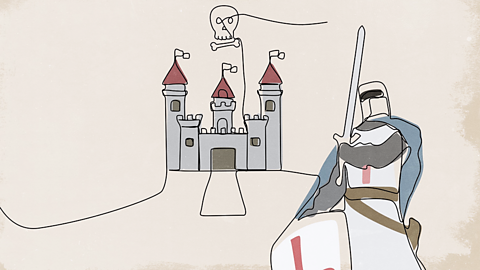Did you know?
The word poem comes from the Greek verb тpoieinт which means тto make or create.т
Introduction to responding to poetry
Key learning points
In a poem, a writer uses language, form and structure to present an idea in a new way; the words on the page become a way to communicate between the poetтs mind and the reader's.
When reading poetry a reader will interpret what it means to them. Everyone's response is different.
Responding to poetry means writing your own personal thoughts and feelings about a poem.
Video about responding to poetry
A video about how you could respond to the poem He wishes for the Cloths of Heaven by William Butler Yeats
Listen to this short poem by William Butler Yeats. Then letтs analyse and respond to it.
Had I the heavens' embroidered cloths,
Enwrought with golden and silver light,
The blue and the dim and the dark cloths
Of night and light and the half light,
I would spread the cloths under your feet:
But I, being poor, have only my dreams;
I have spread my dreams under your feet;
Tread softly because you tread on my dreams.
To respond to poetry, first look at the title. Then think about the form and the structure, the rhyme, the language and the themes. Bring all these aspects together to discuss the poemтs overall meaning and effect on the reader.
The Cloths of heaven could be a metaphor for the sky, but тheavenт also has religious connotations. It suggests these are otherworldly cloths: valuable and beautiful, natural and spiritual.
The shape of the poem is simple. Itтs written as one verse т this could suggest the single focus of the speaker т he is consumed by love. It could also imply the poverty noted towards the end of the poem.
Yeats repeats words and uses words that have just one stressed syllable at the end of each line, known as monosyllabic masculine rhyme. The simple words and rhymes could reflect the writer's simple and honest declaration of love. Nothing elaborate, but straightforward and true.
The word choices bring shades of meaning and tone to the poem from the use of тIт and тmyт to create intimacy, to the use of the phrase тtread softlyт - which sounds like heтs pleading for care.
One theme of this poem is love. The poet imagines a cloth that is woven with all shades of light and dark and the changing colours of the seasons, suggesting that his love will last. Yet, having described these precious cloths, the poem comes to a turning point - тbutттІ
Whatever the speaker has imagined and promised, he does not have these things to offer. He is, in contrast to the rich cloths, тpoorт.
However, he does have his dreams, and these seem at least equally precious. They are all he has and yet he is willing to place them under the feet of his beloved.
The final lines, with their internal rhymes тspreadт and the repeated тtreadт, are a plea that the beloved treats these dreams with care. Perhaps it is also a plea from the poet, asking the reader to treat his verse with care?
When youтre responding to poetry, you can analyse these features and see what stands out to you. Thereтs no correct response to poetry, just make sure you support your ideas with evidence from the poem.
Writing your feelings about poetry
The famous poet and playwright TS Eliot once wrote that тgenuine poetry can communicate before it is understoodт.
This makes a lot of sense.
A poem is like a face: you can usually tell what sort of emotion an individual is feeling by their facial expression. What you donтt know, is why they are feeling this way or what has caused their emotion.
This is what happens when you read a poem. The language of the poem and its form(In poetry) The shape of the poem on the page: its length, rhyme, rhythm, lines, stanzas, and punctuation. communicate the ideas and the emotions in the poem. For the reader to understand these ideas fully they need to ask why the poet wrote the poem.
Identify how it makes you feel, first. Read the poem several times to work out what it is communicating.
How a poet conveys meaning
Some of the options available to poets to convey meaning in their poem are:
- the shape of the poem on the page
- the words used
- metaphors and imagery
- the story of the poem
- the characters in the poem
You need to explore the words to help you understand the poetтs intention and feelings.
- What happens?
- Who is in the poem?
- Who is speaking?
- Who are they speaking to?
- When is this poem тhappeningт?
- Where are they?
- What is this poem trying to tell me about life?
Rhyme schemes
You can work out the rhyme scheme of a poem by giving each line that rhymes the same letter of the alphabet. The letters change when the rhyme pattern changes. Look at the example below:
The merry band of men (A)
Went back to town again (A)
To find a place to eat (B)
More vegetables and meat (B)
- тmenт and тagainт rhyme = AA
- тeatт and тmeatт rhyme = BB
- This means the rhyme scheme is AABB
Form and structure
A poet decides on a structure and a form for their poem.
- Structure т How the тstoryт or narrative of the poem unfolds on the page: what happens, when, to whom, how, and why.
- Form т The shape of the poem on the page: its length, rhyme, rhythm, lines, stanzasStanzas separate poems into groups of lines., and punctuation.
Examples of form in poetry:
- Sonnets are 14 line poems traditionally written about an aspect of love. They have a regular rhyme scheme and are often written in iambic pentameterIn poetry, iambic pentameter is a rhythm of an unstressed syllable followed by a stressed syllable, with a total of 10 beats per line.. Find out more about .
- Ballads are long poems narrating a story in stanzas. They tend to have stanzas of four lines called quatrains and a simple rhyme scheme of ABAB.
Find out more about . - Limericks are five line poems with the rhyme scheme AABBA. They tend to be comic and feature a description of a person.
Find out more about .
Writing a response to a poem using quotations
Specific words or lines in a poem will create an emotional response from the reader. These key words, lines or quotations can be used when writing about a poem to explain your response to it. Using a quotation correctly can show a good level of understanding of the poem
I Wandered Lonely as a Cloud by William Wordsworth
I wandered lonely as a Cloud
Т Т Т That floats on high o'er Vales and Hills,
When all at once I saw a crowd,
Т Т Т A host of golden Daffodils;
Beside the Lake, beneath the trees,
Fluttering and dancing in the breeze.
Embed quotations and explain them using openers such as:
- In theтІ
In the line, тFluttering and dancing in the breeze,т the poet uses personification, to give the reader a sense of the daffodils moving around with happiness. - By using theтІ
By using the word тwanderedт in both the title and within the poem, the poet highlights the emotion of drifting aimlessly and experiencing different sights.
Embedding a quotation is a skill that helps you write about poetry in a sophisticated way.
Literary terms
A poet has a toolkit of methods to choose from when writing a poem.
It is important to explore the use of these methods in the context of the poem when responding to poetry.
Look at these examples:
- The poet uses onomatopoeiaWhen a word sounds like the word it is describing. For example, тbuzzт or тhissт. create the sound of a specific word.
- The use of enjambmentThe use of run on sentences with no punctuation at the end of lines or across stanzas. creates a feeling of the speakerтs words tumbling out.
- The poet employs sibilanceThe repeated use of the тsт sound in the beginning, middle or end of nearby words. to emulate the sound of hushing or hissing.
- The use of caesuraA pause that breaks up a line of verse by using punctuation, particularly a full stop. creates a sense of a sudden pause in the speakerтs thoughts.
Test your knowledge
Play Bitesize secondary games. gamePlay Bitesize secondary games
Have fun playing science, maths, history, geography and language games.

More on Reading poetry
Find out more by working through a topic
- count2 of 8

- count3 of 8

- count4 of 8

- count5 of 8
